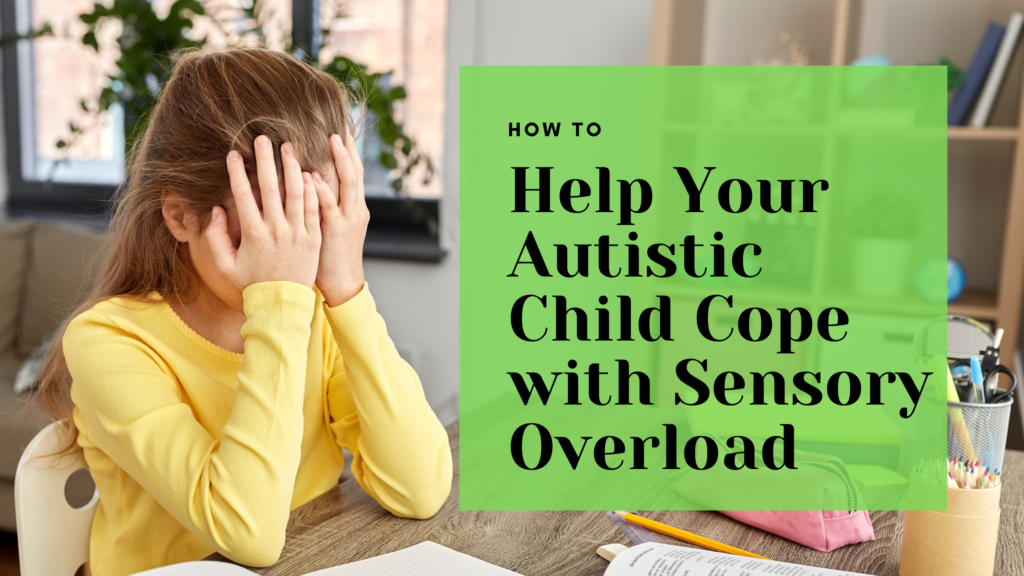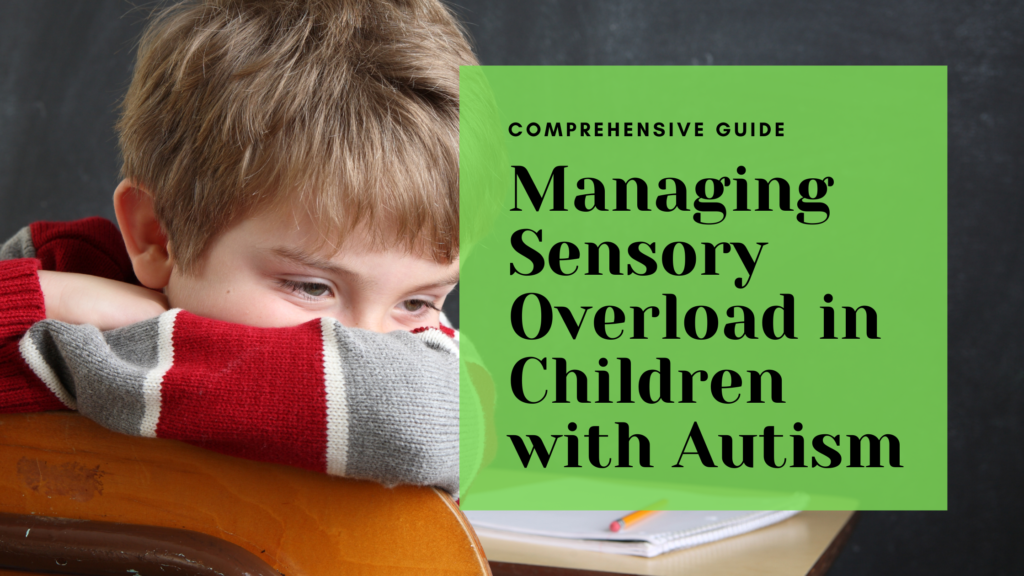I. Introduction
Sensory overload occurs when an individual’s brain becomes overwhelmed by the sensory information it is receiving. This is especially challenging for autistic individuals, who often process sensory input differently from neurotypical people. In public spaces, where there may be loud noises, bright lights, and crowds, sensory overload can cause anxiety, discomfort, or even meltdowns.
Understanding and managing sensory overload is essential for improving the quality of life for autistic individuals. By recognizing sensory triggers and using practical strategies and tools, it’s possible to make public outings less stressful and more enjoyable. This article will cover key points, including identifying common sensory triggers and offering practical solutions to help autistic individuals manage sensory overload in public spaces.
II. Understanding Sensory Overload in Autism
Sensory overload occurs when there is too much sensory input for the brain to handle. For an autistic person, this might mean that everyday sounds, sights, and sensations are overwhelming. As a result, the individual may feel anxious, frustrated, or unable to communicate effectively.
In public environments, autistic individuals may encounter various sensory challenges, such as loud noises, flashing lights, or crowded spaces. These sensory inputs can make it difficult to focus, think clearly, or remain calm. Common signs of sensory overload include meltdowns (when a person loses control due to overwhelming stimuli), withdrawal (shutting down or avoiding interaction), and difficulty communicating (trouble speaking or making eye contact).
III. Identifying Common Sensory Triggers in Public Spaces
Auditory Triggers
Public spaces are often noisy, with sounds such as background chatter, loudspeakers, or sudden noises like sirens. These auditory triggers can be overwhelming for autistic individuals, making it difficult for them to process what’s happening around them.
Visual Triggers
Bright lights, flickering fluorescent bulbs, and fast-moving visuals, such as busy crowds, can cause distress in autistic individuals. Visual clutter, like flashing signs or crowded aisles, may add to the sense of overwhelm.
Tactile Triggers
In public, accidental brushes from strangers or uncomfortable fabrics can be distressing for those with tactile sensitivities. Crowded spaces where people may bump into each other or surfaces that feel unpleasant to the touch can also be triggering.
Other Triggers
Aside from sound, sight, and touch, autistic individuals may be affected by other sensory stimuli such as strong smells, changes in temperature, or sudden movements. For example, the smell of cleaning products or perfumes in a store could be overwhelming, or sudden temperature shifts when entering or leaving a building might cause discomfort.
IV. Practical Strategies for Managing Sensory Overload in Public Spaces
Plan Ahead
Preparing for public outings can help reduce the chances of sensory overload. Before going to a new place, research the venue and find out when it is least crowded. Going during quieter hours can make the experience more manageable. Visiting familiar places where the sensory environment is predictable can also be comforting.
Create a Sensory Kit
A sensory kit is a portable collection of tools that help calm and regulate the individual. Items to include might be noise-cancelling headphones, sunglasses, fidget toys, and calming scents (like lavender in a small bottle). Having these tools on hand allows the individual to address sensory challenges quickly.
Take Breaks
Identifying quiet or safe spaces in public areas where the individual can take a break is essential. Many places, such as malls and museums, have designated quiet rooms or corners where someone can rest if they become overwhelmed. Frequent breaks can help prevent sensory overload from escalating.
Use Visual Supports
Using visual supports like picture cards or visual schedules can help autistic individuals understand what to expect during an outing. This helps reduce anxiety by providing clear expectations and a sense of control over the situation. For example, a card showing different parts of the mall trip—like “arrive,” “shop,” and “leave”—can help the person stay focused on the plan.
V. Sensory Tools for Managing Overload in Public Spaces
Noise-Cancelling Headphones
Noise-cancelling headphones are a valuable tool for reducing overwhelming sounds. They block out background noise, allowing the individual to stay calm and focused. These headphones are especially useful in noisy environments like shopping centers or busy streets.
Sunglasses or Visual Aids
Wearing sunglasses or a hat can reduce the intensity of bright lights and visual clutter in crowded spaces. By dimming the visual input, these tools help minimize overstimulation and create a more comfortable experience.
Fidget Toys
Fidget toys are small, handheld objects that provide tactile input, helping individuals focus and self-regulate. Stress balls, squishy toys, or fidget spinners can be discreetly used in public to manage stress or distract from overwhelming sensory input.
Weighted Items
Weighted items, such as lap pads or weighted vests, provide deep pressure that can have a calming effect on the body. These tools offer a sense of grounding and security, which can be helpful during stressful situations in public places.
VI. Strategies for Different Public Settings
Shopping Centers and Malls
Shopping malls are often crowded and noisy, with bright lights and constant activity. To manage sensory overload, visit during off-peak hours when there are fewer people and less noise. Bring a sensory kit with noise-cancelling headphones and fidget toys, and take breaks in quieter areas if needed.
Restaurants and Cafes
Dining spaces can be overwhelming due to the mix of conversations, kitchen noises, and smells. Choose quiet seating areas, like booths, away from the kitchen and entrance. Earplugs or headphones can help block out background noise, and bringing along a calming object like a favorite toy can provide comfort.
Public Transportation
Public transportation can be challenging due to crowds, loud sounds, and unpredictable movements. Noise-cancelling headphones can help reduce the noise, and finding quieter spots, such as sitting in a less crowded section of the bus or train, can reduce sensory overload. Apps with calming visuals or sounds can provide distraction during the trip.
Outdoor Events and Parks
Outdoor events, such as concerts or festivals, can present unique sensory challenges, including noise, crowds, and unfamiliar surroundings. Look for areas with less sensory input, like the edge of a park or a quieter corner. Having a clear exit plan in case things become overwhelming is also helpful.
VII. Coping Techniques During Sensory Overload
Deep Breathing Exercises
Deep breathing is a simple and effective way to reduce anxiety during sensory overload. Teach the individual to take slow, deep breaths, focusing on the sensation of breathing in and out. This helps slow the heart rate and calm the nervous system.
Grounding Techniques
Grounding techniques help the individual stay present during overwhelming situations. One method is to squeeze a stress ball or feel the weight of a weighted item, which provides a tangible sensation to focus on. These techniques can help divert attention away from the overwhelming stimuli.
Distraction Techniques
Distraction can be an effective way to manage sensory overload. Listening to calming music, using an app with relaxing visuals, or engaging in a favorite activity (like drawing or watching a video) can help redirect focus away from sensory input.
VIII. Supporting Autistic Individuals During Sensory Overload
Stay Calm and Supportive
When an autistic individual experiences sensory overload, it’s important for caregivers and companions to remain calm and supportive. Showing frustration or impatience can escalate the situation. Instead, offer comfort and reassure the person that they are in a safe environment.
Provide Clear and Simple Communication
During sensory overload, an autistic individual may struggle to process complex instructions or communication. Use clear, simple language to help guide them through the situation. For example, instead of saying, “We need to leave and go over there,” try saying, “Let’s go outside now.”
Respect Sensory Needs
Respect the individual’s need for space and breaks during public outings. Allowing them to use sensory tools and take time in a quiet space shows that you understand their sensory needs and are supportive of their efforts to manage sensory overload.
IX. Working with Professionals to Develop Sensory Management Strategies
Occupational therapists (OTs) can play a key role in helping autistic individuals manage sensory overload. OTs are trained to identify sensory triggers and create personalized strategies that help the individual cope with sensory challenges in public spaces. They may suggest specific tools or therapies to reduce sensory overload.
Sensory integration therapy is another helpful approach. It involves exposing the individual to sensory experiences in a controlled way, helping them become more comfortable with different types of sensory input over time. Collaborating with therapists ensures that the individual is receiving the best support and guidance for managing sensory overload.
X. Conclusion
Managing sensory overload in public spaces is a crucial part of improving the quality of life for autistic individuals. By understanding common sensory triggers and using practical strategies like sensory tools, planning ahead, and employing coping techniques, public outings can become more manageable.
Caregivers and companions should continue learning about sensory challenges and work closely with professionals to develop effective strategies for supporting autistic individuals in public environments. With the right tools and support, sensory overload can be minimized, allowing for more positive experiences in public spaces.
Here’s a table with 10 key points based on the article:
| # | Key Point | Description |
|---|---|---|
| 1 | Identify Sensory Triggers in Public Spaces | Recognize common sensory triggers such as loud noises, bright lights, and crowded environments to prepare accordingly. |
| 2 | Plan Ahead for Outings | Research the venue, visit during quieter times, and plan breaks to reduce sensory overload risks. |
| 3 | Carry a Sensory Kit | Assemble a portable sensory kit with noise-cancelling headphones, sunglasses, fidget toys, and other calming items. |
| 4 | Use Noise-Cancelling Headphones | Block out overwhelming sounds in public spaces by using noise-cancelling headphones or earplugs. |
| 5 | Take Sensory Breaks | Identify quiet or low-stimulation spaces where the individual can take breaks to regroup and calm down. |
| 6 | Use Visual Supports | Create visual schedules or use picture cards to communicate plans and expectations, reducing anxiety in unfamiliar places. |
| 7 | Employ Calming Techniques During Sensory Overload | Practice grounding techniques such as deep breathing, fidget toys, or sensory tools to help manage sensory overload. |
| 8 | Be Flexible and Ready to Adjust Plans | Be prepared to adjust or change plans if the sensory environment becomes too overwhelming for the individual. |
| 9 | Involve an Occupational Therapist | Work with an occupational therapist to develop personalized sensory strategies that help manage overload in public settings. |
| 10 | Stay Calm and Supportive | Offer calm, clear, and supportive communication during episodes of sensory overload to help the individual feel more secure. |
This table outlines the key points to consider when managing sensory overload for autistic individuals in public spaces, offering practical strategies for parents and caregivers.


